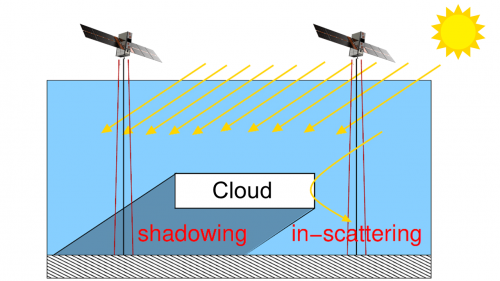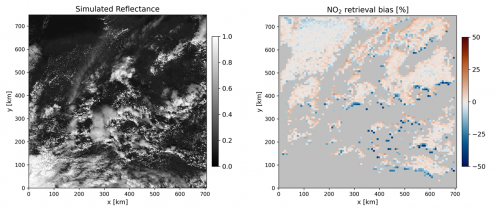Satellite instruments measure solar radiation reflected from the Earth's surface and atmosphere. For an ideally cloudless atmosphere, the amount of various atmospheric trace gases may be estimated from these measurements.
However, observed scenes in satellite images are often contaminated by clouds, which reduce the quality of the measurements. Even ground pixels that do not contain clouds may be affected by clouds due to in-scattering of radiation from clouds in neighbouring pixels or cloud shadow effects.
To quantify the impact of realistic 3D clouds on trace gas measurements, we have used a state-of-the-art 3D radiative transfer model to simulate cloud-contaminated satellite images and assess the impact of 3D cloud effects on the retrieval of nitrogen dioxide (NO2).
The cloud shadows may underestimate the NO2 column by tens of percent. The magnitude of the error varies with the solar zenith angle, satellite viewing geometry, cloud height and thickness, trace gas vertical profile shape and surface albedo. 3D cloud impacts increase the NO2 uncertainty and measurements suffering from this should either be flagged or corrected.
References:
- Emde, C., Yu, H., Kylling, A., van Roozendael, M., Stebel, K., Veihelmann, B., and Mayer, B.: Impact of 3D cloud structures on the atmospheric trace gas products from UV–Vis sounders – Part 1: Synthetic dataset for validation of trace gas retrieval algorithms, Atmos. Meas. Tech., 15, 1587–1608, https://doi.org/10.5194/amt-15-1587-2022, 2022.
- Yu, H., Emde, C., Kylling, A., Veihelmann, B., Mayer, B., Stebel, K., and Van Roozendael, M.: Impact of 3D cloud structures on the atmospheric trace gas products from UV–Vis sounders – Part 2: Impact on NO2 retrieval and mitigation strategies, Atmos. Meas. Tech., 15, 5743–5768, https://doi.org/10.5194/amt-15-5743-2022, 2022.
- Kylling, A., Emde, C., Yu, H., van Roozendael, M., Stebel, K., Veihelmann, B., and Mayer, B.: Impact of 3D cloud structures on the atmospheric trace gas products from UV–Vis sounders – Part 3: Bias estimate using synthetic and observational data, Atmos. Meas. Tech., 15, 3481–3495, https://doi.org/10.5194/amt-15-3481-2022, 2022.


